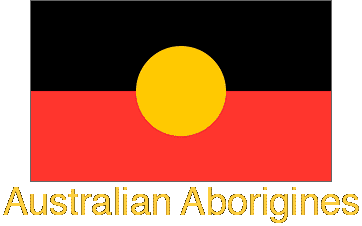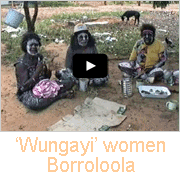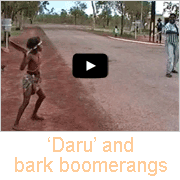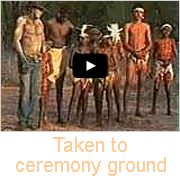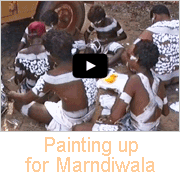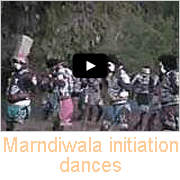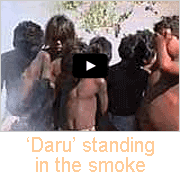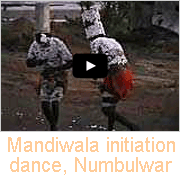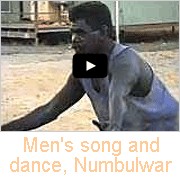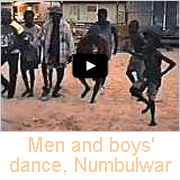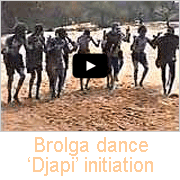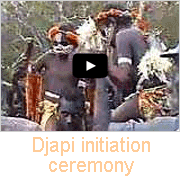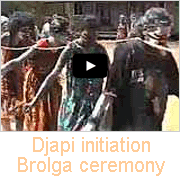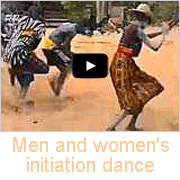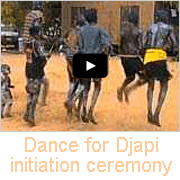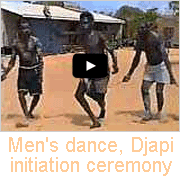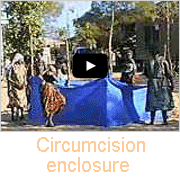Videos of Aboriginal Initiation Ceremonies from Northern Australia
Aboriginal Initiation Ceremonies from Northern Australia
Initiation ceremonies for boys are still a very important part of traditional life in the various communities of the Northern Territory. In most traditional Aboriginal communities of the Top End of Australia boys are initiated into manhood in a cycle of ceremonies that usually takes several days.
The "Mandiwa" or "Marndiwala" initiation ceremony is performed from Barunga (near Katherine) in the west to Borroloola in the east and also in communities further north. As is illustrated here in a ceremony held among the Yanyuwa people of Borroloola, boys are led into a circle of men who, while singing the "kujika", song cycle, associated with the clan affiliation of the "daru", the young initiates, wind "hair belt", woven strands of human hair, around their waists while their mothers and other relatives dance a typical loose-kneed shuffle dance to the many stanzas of the "kujika". The boys then stay together under a bough shelter, looked after by an older man. During this time elder women go around the community, paint themselves with white clay and act in a joking manner; however, they may grab people's property with impunity, sing and dance and generally act quite out of character - it is all part of the law, but great fun.
Rough "boomerangs" are made of bark and given to the "daru", the young initiates who are then taken by some of the older men around the community; they try to hit other men with those: those men will then later be dancing for them in their ceremony. There are mock fights, but all in good fun, although the initiates themselves keep a solemn face and run, one thumb hooked in their hair-string belt, in the ways a daru should behave.
A few days later the "daru" initiates are painted with red ochre and may be decked out with a headdress of cockatoo feathers. To accompany the boys to the "Jamangki" (ceremonial) ground for the evening ceremonies a crowd of men and boys, painted with white clay, run in single file towards the initiates, dance around them and emit a high-pitched yell; the initiates then walk a few metres, stop again and the performance is repeated until finally the ceremonial ground is reached where men are singing while clapping boomerangs together and women dance their shuffling dance. The boys are then hoisted on the men's shoulders and carried to their fathers sitting in front of the windbreak on the "Jamangki" ground.
The following day young men (including boys already initiated) are painted up and cotton wool is stuck to their bodies in patterns associated with their clan affiliations, getting ready to dance that night for young initiates. The decorated dancers, who will be dancing for the boys all through the night, march in single file to the ceremonial ground at dusk. While men sing and clap boomerangs together, men with elaborate headdresses then dance towards the initiates who sit with their tribal fathers. They dance until daybreak; the boys are then circumcised at sunrise. A couple of days later they are walked back to the general camp where a smoky fire of eucalyptus leaves is made and the boys have to stand in the smoke. Their sisters are present, but are not allowed to look at them and therefore cover themselves. After few days they are then painted all over with red ochre one last time and are free to join the general community again.
This ceremony, also called "Mandiyala" or "Mandiwala" (Marndiwala), may also be performed in the northern part of the Northern Territory. Boys, often very young, as in Numbulwar, are decorated and go around with toy spears, trying to hit men who will later then have to dance for them in the all-night ceremony. At dusk the dancers, who have been decorated with cotton wool stuck to their bodies in ceremonial patterns, march in single file to the ceremonial ground; a woman brushes each of the dancer's legs with a piece of material. While men sing and clap boomerangs together, two men with elaborate headdresses then dance towards the initiates who sit with their tribal fathers in front of a windbreak at the top of the ceremony place. That night they will dance until daybreak after which the boys are circumcised.
A type of initiation ceremony, typical of Arnhem Land is called "Djapi" in which initiates' faces and torso are painted with clan designs. As illustrated here in a ceremony held in Numbulwar, on the eastern shore of Arnhem Land, men and women perform various totemic dances, accompanied by chanting, didjeridu and clapsticks. This can be fairly informal, without traditional decorations, where the boy(s) to be initiated sits between a group of men who sing while young men and boys get up and dance, to the cheers of onlookers. The initiates, around the age of nine years old, have their faces painted while the women dance. The following day a large group of mean and women, visitors from Arnhem Land communities, perform a ceremony associated with the dreaming of the "Brolga", a large water bird; they imitate its call throughout the performance. The boys are then taken to have their chests painted in intricate clan designs that may not be seen by the women. An enclosure has been set up by the women where the boys will be circumcised, a procedure that may be watched only by the men, although the women are close by. The enclosure is thereafter demolished and further dances take place while the boys are looked after by the men after their ordeal.
